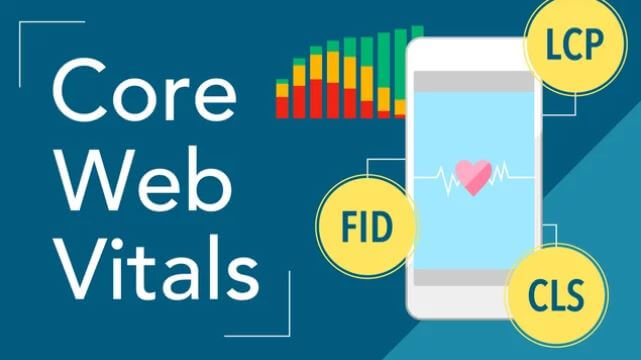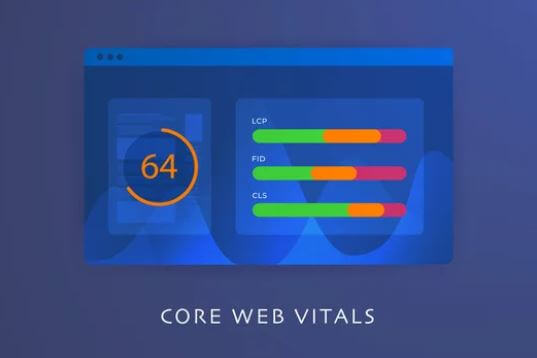Core Web Vitals
Introduction:
In recent years, the speed and performance of websites have become increasingly important. Google has recognized this and introduced the concept of Core Web Vitals. These are a set of metrics that measure critical aspects of user experience and help website owners and developers to optimize their sites for performance.
What are Core Web Vitals?
Core Web Vitals is a set of metrics that measure critical aspects of website user experience. They are part of Google’s overall effort to improve the performance and usability of the web. The metrics that makeup Core Web Vitals are designed to measure three key areas of user experience: loading, interactivity, and visual stability. These metrics are:
- Largest Contentful Paint (L.C.P.): This metric measures the loading speed of the most significant element on a web page, such as an image or a video.
- First Input Delay (FID): This metric measures the time it takes for a web page to respond to a user’s first interaction, such as clicking a button or a link.
- Cumulative Layout Shift (C.L.S.): This metric measures the visual stability of a web page or how much the layout of a page shifts while it is loading.
Why are Core Web Vitals Important?
Core Web Vitals are essential because they provide a standardized set of metrics that website owners and developers can use to measure the user experience of their sites. By optimizing for these metrics, website owners can ensure that their sites load quickly, respond to user interactions promptly, and maintain visual stability throughout the user’s session.
Furthermore, Core Web Vitals have become a part of Google’s overall ranking algorithm. This means that websites that perform well on these metrics are more likely to rank higher in search results than sites that do not.
How is Core Web Vitals Measured?
Core Web Vitals are measured using a combination of field data and lab data. Field data is collected from real users who visit a website and is used to measure the actual performance of a site in the wild. On the other hand, lab data is collected in a controlled environment and is used to test a site’s performance under ideal conditions.
To measure Core Web Vitals, website owners and developers can use various tools, including Google’s own PageSpeed Insights and Lighthouse and other third-party tools such as WebPageTest and GTmetrix.
Core Web Vitals is an essential metric set that measures critical aspects of website user experience. By optimizing for these metrics, website owners and developers can ensure that their sites load quickly, respond to user interactions promptly, and maintain visual stability throughout the user’s session. Furthermore, Core Web Vitals have become a part of Google’s overall ranking algorithm, making them even more important for website owners who want to improve their search rankings.
Core Web Vitals Metrics:
Core Web Vitals is a set of metrics that measure critical aspects of website user experience. They are designed to measure three key areas of user experience: loading, interactivity, and visual stability. The three metrics that makeup Core Web Vitals are:
Largest Contentful Paint (L.C.P.):
The largest Contentful Paint measures the loading speed of the most significant element on a web page, such as an image or a video. It is an important metric because it measures the perceived loading speed of a page, which is the amount of time it takes for the page to appear fully loaded to the user. A good L.C.P. score is achieved when the most significant element on the page loads within 2.5 seconds of the page starting to pack.
First Input Delay (FID):
First, Input Delay measures the time it takes for a web page to respond to a user’s first interaction, such as clicking a button or a link. It is an important metric because it measures the responsiveness of a page to user input. A good FID score is achieved when a page responds to user input within 100 milliseconds.
Cumulative Layout Shift (C.L.S.):
Cumulative Layout Shift measures the visual stability of a web page or how much the layout of a page shifts while it is loading. It is an important metric because it measures how much layout shifts on a page disrupt the user’s experience. A good C.L.S. score is achieved when the page has a maximum layout shift of 0.1.
Core Web Vitals Metrics are an essential set of metrics that measure critical aspects of website user experience. By optimizing for these metrics, website owners and developers can ensure that their sites load quickly, respond to user interactions promptly, and maintain visual stability throughout the user’s session. IWebsite owners and developers must pay close attention to these metrics to provide their visitors with the best possible user experience.
How to Improve Core Web Vitals:
Improving Core Web Vitals is essential for providing a great user experience on your website. Here are some tips on how to improve each of the three metrics:
Largest Contentful Paint (L.C.P.):
To improve L.C.P., you can:
- Optimize images and videos by compressing them and reducing their file size.
- Use a content delivery network (C.D.N.) to deliver assets more quickly.
- Prioritize the above-the-fold content to load before other elements on the page.
- Minimize the number of server requests by using a caching system.
First Input Delay (FID):
To improve FID, you can:
- Minimize the amount of JavaScript that runs on a page.
- Defer non-critical JavaScript until after the page has loaded.
- Optimize server response times by reducing the time it takes for the server to process a request.
- Use a service worker to cache critical resources to be loaded quickly.
Cumulative Layout Shift (C.L.S.):
To improve C.L.S., you can:
- Reserve space for ads and images to prevent them from pushing other content around.
- Set dimensions for images and videos, so the browser knows how much space to reserve for them.
- Avoid inserting new elements above existing content while the page is loading.
- Use CSS to specify the size and position of elements.
In addition to these tips, it’s essential to monitor your website’s Core Web Vitals regularly. You can use tools like Google’s PageSpeed Insights or Lighthouse to identify areas for improvement.
It’s also important to remember that improving Core Web Vitals is ongoing. As your website evolves and grows, it’s important to continue optimizing for these metrics to provide the best possible user experience.
Finally, it’s worth noting that Core Web Vitals are just one aspect of website optimization. Other essential factors include website security, accessibility, and mobile responsiveness. By focusing on all of these aspects, you can ensure that your website provides a great user experience for all visitors.
Core Web Vitals and SEO:
Core Web Vitals are essential in Search Engine Optimization (SEO). Here’s how:
Google’s Page Experience Update:
Google has announced that starting in May 2021, Core Web Vitals will become a part of the search engine’s ranking algorithm. This means that websites that score well on Core Web Vitals may see a boost in search engine rankings, while sites that perform poorly may decrease.
User Experience:
Core Web Vitals are designed to measure critical aspects of website user experience. By optimizing for these metrics, website owners and developers can provide a better user experience for visitors. This can lead to longer visit durations, lower bounce rates, and higher engagement, contributing to better search engine rankings.
Mobile-Friendliness:
Core Web Vitals are especially important for mobile devices, which account for most internet traffic. Websites that perform well on Core Web Vitals are more likely to be mobile-friendly, an essential factor in search engine rankings.
Competition:
As Core Web Vitals become a more critical factor in search engine rankings, website owners and developers who prioritize optimization for these metrics may gain a competitive advantage over those who do not.
To improve your website’s Core Web Vitals and SEO, follow the tips outlined in the previous sections. In addition, make sure your website is mobile-friendly, as this is an essential factor in search engine rankings. Use tools like Google’s Mobile-Friendly Test to identify areas for improvement.
It’s also worth noting that Core Web Vitals are just one factor in search engine optimization. Other essential elements include website content, backlinks, and domain authority. Focus on these aspects can improve your website’s overall SEO and drive more traffic.
Core Web Vitals and User Experience:
Core Web Vitals are designed to measure critical aspects of website user experience. Here’s how optimizing for these metrics can improve the user experience:
Faster Load Times:
The Largest Contentful Paint (L.C.P.) metric measures how quickly the most significant element on the webpage loads. By optimizing for L.C.P., website owners and developers can ensure that the most crucial part of the page loads quickly, improving the overall load time of the page. This can lead to a better user experience, as visitors are less likely to abandon a slow-loading website.
Responsive Interactions:
The First Input Delay (FID) metric measures the responsiveness of a webpage. By optimizing for FID, website owners and developers can ensure that the page responds quickly to user interactions such as clicks and taps. This can lead to a more responsive and interactive user experience, improving engagement and reducing frustration.
Consistency:
The Cumulative Layout Shift (C.L.S.) metric measures the stability of a webpage’s layout. By optimizing for C.L.S., website owners and developers can ensure that elements on the page do not shift around unexpectedly, leading to a more consistent and predictable user experience.
Accessibility:
Optimizing for Core Web Vitals can also improve the accessibility of a website. For example, optimizing for L.C.P. can make it easier for users with slower internet connections to access the content they need, while optimizing for FID can make it easier for users with disabilities to interact with the website.
In addition to improving user experience, optimizing Core Web Vitals can improve website performance and increase engagement. By providing a fast, responsive, and consistent user experience, website owners and developers can build trust and loyalty with their audience, leading to more repeat visits and higher conversion rates.
To optimize for Core Web Vitals and improve user experience, follow the tips outlined in the previous sections. Monitor your website’s Core Web Vitals regularly using tools like Google’s PageSpeed Insights or Lighthouse, and make improvements as needed. By prioritizing user experience and optimizing for Core Web Vitals, you can build a website that provides a great user experience for all visitors.
Conclusion:
Core Web Vitals is a set of metrics that measure critical aspects of website user experience. By optimizing for these metrics, website owners and developers can improve website performance, increase engagement, and boost search engine rankings.
Here are the key takeaways from this article:
- Core Web Vitals include three metrics: Largest Contentful Paint (L.C.P.), First Input Delay (FID), and Cumulative Layout Shift (C.L.S.).
- L.C.P. measures how quickly the most significant element on the webpage loads, FID measures the page’s responsiveness, and C.L.S. measures the stability of the page’s layout.
- Optimizing for Core Web Vitals can improve user experience by providing faster load times, responsive interactions, consistency, and accessibility.
- Core Web Vitals are also crucial for search engine optimization, as Google has announced that they will become a part of the search engine’s ranking algorithm starting in May 2021.
- To improve Core Web Vitals, website owners and developers can use various techniques, including optimizing images and videos, minifying code, reducing server response times, and prioritizing above-the-fold content.
Core Web Vitals is essential to website performance and user experience. By understanding and optimizing for these metrics, website owners and developers can build websites that provide a fast, responsive, and consistent user experience, leading to higher engagement, better search engine rankings, and, ultimately, more success online.
F.A.Q.
What are the three pillars of Core Web Vitals?
The three pillars of Core Web Vitals are:
- Loading: This pillar is measured by the Largest Contentful Paint (L.C.P.) metric, which measures how long it takes for the most significant element on a webpage to load. The loading pillar is important because users expect websites to load quickly, and slow loading times can lead to high bounce rates and lower engagement.
- Interactivity: This pillar is measured by the First Input Delay (FID) metric, which measures how quickly a webpage responds to user interactions such as clicks and taps. The interactivity pillar is important because users expect websites to respond promptly to their actions, and slow response times can lead to frustration and lower engagement.
- Visual stability: This pillar is measured by the Cumulative Layout Shift (C.L.S.) metric, which measures how much the content on a webpage moves around while it is loading. The visual stability pillar is important because users expect websites to be stable and predictable, and unexpected layout shifts can lead to confusion and lower engagement.
Together, these three pillars provide a comprehensive view of the user experience on a website. Optimizing for all three can lead to a fast, responsive, and stable website, providing an excellent experience for all users.
What are good scores for Core Web Vitals?
Google defines good scores for Core Web Vitals as:
- Largest Contentful Paint (L.C.P.): Good L.C.P. scores are less than 2.5 seconds.
- First Input Delay (FID): Good FID scores are less than 100 milliseconds.
- Cumulative Layout Shift (C.L.S.): Good C.L.S. scores are less than 0.1.
It’s important to note that these are the thresholds for what Google considers a good score and that different websites and industries may have other benchmarks based on user expectations and website goals.
Furthermore, it’s essential to remember that Core Web Vitals scores are just one aspect of website performance and user experience. While optimizing for these metrics is critical, website owners and developers should consider other factors, such as accessibility, usability, and content quality, to provide a great user experience.







